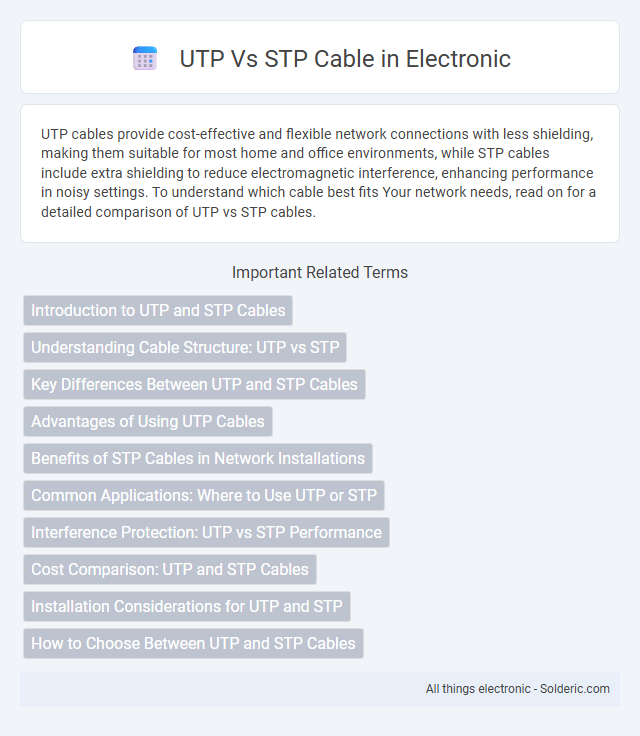UTP cables provide cost-effective and flexible network connections with less shielding, making them suitable for most home and office environments, while STP cables include extra shielding to reduce electromagnetic interference, enhancing performance in noisy settings. To understand which cable best fits Your network needs, read on for a detailed comparison of UTP vs STP cables.
Comparison Table
| Feature | UTP Cable | STP Cable |
|---|---|---|
| Full Form | Unshielded Twisted Pair | Shielded Twisted Pair |
| Shielding | No shielding | Foil or braid shielding around pairs |
| Interference Protection | Lower protection against EMI | High protection against EMI and crosstalk |
| Cost | Less expensive | More expensive |
| Installation | Easy to install and flexible | Bulkier and less flexible, complex grounding |
| Use Case | Common in LANs and telephony | Used in environments with high EMI |
| Bandwidth | Supports up to 1 Gbps (Cat5e, Cat6) | Supports up to 10 Gbps (Cat6a, Cat7) |
| Data Transmission | Generally suitable for short distances | Better performance over longer distances |
Introduction to UTP and STP Cables
Unshielded Twisted Pair (UTP) cables consist of pairs of insulated copper wires twisted to reduce electromagnetic interference, commonly used in Ethernet networks and telephone systems. Shielded Twisted Pair (STP) cables incorporate an additional shielding layer around the wire pairs or the overall cable, providing enhanced protection against external electromagnetic interference and crosstalk. The choice between UTP and STP depends on environmental factors, with STP preferred in high-interference areas and UTP favored for cost-effective, less demanding installations.
Understanding Cable Structure: UTP vs STP
UTP (Unshielded Twisted Pair) cables consist of pairs of insulated copper wires twisted together without additional shielding, which reduces electromagnetic interference primarily through the twisting technique. STP (Shielded Twisted Pair) cables feature an extra layer of shielding, such as a foil or braided mesh, around each pair or overall cable, providing superior protection against external electromagnetic interference and crosstalk. The structural difference impacts cable performance in environments with high interference, making STP more suitable for industrial or high-noise settings while UTP is cost-effective for typical office or home networking.
Key Differences Between UTP and STP Cables
UTP (Unshielded Twisted Pair) cables lack shielding, making them lighter and more flexible but more susceptible to electromagnetic interference (EMI) compared to STP (Shielded Twisted Pair) cables, which include a shielding layer to protect against EMI and crosstalk. STP cables offer better performance in environments with high interference, such as industrial settings, while UTP cables are more cost-effective and easier to install in office and residential networks. Your choice between UTP and STP should depend on the level of interference in your network environment and budget constraints.
Advantages of Using UTP Cables
UTP cables offer superior flexibility and ease of installation due to their lightweight design and lack of shielding, reducing overall infrastructure costs. They provide adequate performance for most Ethernet networking applications, supporting data rates up to 10 Gbps over short distances. The absence of shielding in UTP cables minimizes susceptibility to electromagnetic interference in controlled environments, making them ideal for office and residential networking.
Benefits of STP Cables in Network Installations
STP cables provide enhanced protection against electromagnetic interference (EMI) and crosstalk due to their shielding, making them ideal for environments with high electrical noise. Their robust shielding improves data transmission reliability and reduces error rates in critical network installations. STP cables also support higher bandwidth and longer transmission distances compared to UTP cables, optimizing network performance and stability.
Common Applications: Where to Use UTP or STP
UTP cables are commonly used in office networks, home internet setups, and telephone systems due to their cost-effectiveness and ease of installation. STP cables, with their shielding against electromagnetic interference, are ideal for industrial environments, data centers, and areas with high electrical noise. Choosing between UTP and STP depends on your installation environment and the level of signal protection required.
Interference Protection: UTP vs STP Performance
STP cables provide superior interference protection compared to UTP cables due to their shielding layers that guard against electromagnetic interference (EMI) and crosstalk. UTP cables, lacking this shielding, are more susceptible to noise and signal degradation in environments with high EMI. As a result, STP cables are preferred in industrial settings or areas with significant electronic interference for enhanced performance and data integrity.
Cost Comparison: UTP and STP Cables
UTP (Unshielded Twisted Pair) cables typically cost less than STP (Shielded Twisted Pair) cables due to simpler manufacturing and fewer materials required for shielding. The added shielding in STP cables increases both production and installation expenses, as grounding is often necessary to prevent electromagnetic interference. For budget-sensitive projects, UTP cables offer a more economical choice while STP cables provide enhanced protection in environments with significant electrical noise.
Installation Considerations for UTP and STP
UTP cables are easier to install due to their flexibility and thinner insulation, making them ideal for tight spaces and quick deployments. STP cables require careful grounding and shielding to prevent interference, increasing installation complexity and time. Your network environment's susceptibility to electromagnetic interference will dictate the choice and installation method of either cable type.
How to Choose Between UTP and STP Cables
When choosing between UTP and STP cables, consider the environment where your network will operate; UTP cables are suitable for general use with minimal interference, providing cost-effective and flexible solutions. STP cables include shielding that protects against electromagnetic interference, making them ideal for industrial or high-interference areas where data integrity is crucial. Your decision should balance budget constraints, installation environment, and network performance requirements to optimize connectivity and reliability.
UTP vs STP cable Infographic

 solderic.com
solderic.com